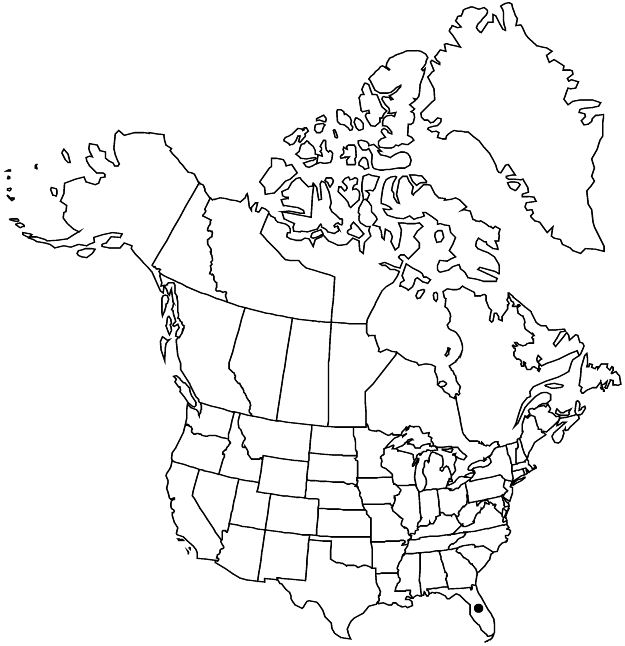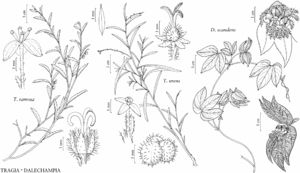Difference between revisions of "Dalechampia scandens"
Sp. Pl. 2: 1054. 1753.
FNA>Volume Importer |
imported>Volume Importer |
||
| (3 intermediate revisions by 2 users not shown) | |||
| Line 13: | Line 13: | ||
}}{{Treatment/ID/Special_status | }}{{Treatment/ID/Special_status | ||
|code=F | |code=F | ||
| − | |label= | + | |label=Illustrated |
}} | }} | ||
|basionyms= | |basionyms= | ||
| Line 31: | Line 31: | ||
|elevation=0–10 m. | |elevation=0–10 m. | ||
|distribution=Dry subtropical forests and scrub;Fla.;Mexico;West Indies;Central America;South America. | |distribution=Dry subtropical forests and scrub;Fla.;Mexico;West Indies;Central America;South America. | ||
| + | |introduced=true | ||
|discussion=<p><i>Dalechampia scandens</i> is widespread, variable (W. S. Armbruster 1985), and probably a complex of cryptic species (C. Pélabon et al. 2005). The species is naturalized in Broward and Hillsborough counties; the geographic origin of these populations is uncertain (see R. W. Pemberton and H. Liu 2008b).</p> | |discussion=<p><i>Dalechampia scandens</i> is widespread, variable (W. S. Armbruster 1985), and probably a complex of cryptic species (C. Pélabon et al. 2005). The species is naturalized in Broward and Hillsborough counties; the geographic origin of these populations is uncertain (see R. W. Pemberton and H. Liu 2008b).</p> | ||
|tables= | |tables= | ||
| Line 40: | Line 41: | ||
-->{{#Taxon: | -->{{#Taxon: | ||
name=Dalechampia scandens | name=Dalechampia scandens | ||
| − | |||
|authority=Linnaeus | |authority=Linnaeus | ||
|rank=species | |rank=species | ||
| Line 55: | Line 55: | ||
|publication title=Sp. Pl. | |publication title=Sp. Pl. | ||
|publication year=1753 | |publication year=1753 | ||
| − | |special status=Introduced; | + | |special status=Introduced;Illustrated |
| − | |source xml=https:// | + | |source xml=https://bitbucket.org/aafc-mbb/fna-data-curation/src/2e0870ddd59836b60bcf96646a41e87ea5a5943a/coarse_grained_fna_xml/V12/V12_427.xml |
|genus=Dalechampia | |genus=Dalechampia | ||
|species=Dalechampia scandens | |species=Dalechampia scandens | ||
Latest revision as of 20:15, 5 November 2020
Stems 1–5 m, hirsute, with stinging hairs. Leaves: stipules lanceolate to ovate, 3–8 × 2 mm; petiole 2–8 cm; blade ovate, 3–10 × 3–13 cm, usually deeply 3-lobed, base shallowly to deeply cordate, margins weakly serrulate-crenulate, apex acute or acuminate. Inflorescences: peduncle of inflorescence 2–6 cm; involucral bracts greenish white at anthesis, broadly ovate, 1.5–3 × 1.5–3 cm, deeply 3-lobed, with 5 major veins; peduncle of staminate cymule 1–10 mm; pistillate cymule nearly sessile. Pistillate flowers: sepals pinnatifid, with stiff, detaching hairs and, often, stalked, resiniferous glands; styles 4–8 mm; stigma 0.5 mm diam. Capsules glabrescent to finely pubescent. Seeds 3.5–4 mm, smooth.
Phenology: Flowering and fruiting year-round, especially at end of summer/rainy season.
Habitat: Dry subtropical forests and scrub.
Elevation: 0–10 m.
Distribution

Introduced; Dry subtropical forests and scrub, Fla., Mexico, West Indies, Central America, South America.
Discussion
Dalechampia scandens is widespread, variable (W. S. Armbruster 1985), and probably a complex of cryptic species (C. Pélabon et al. 2005). The species is naturalized in Broward and Hillsborough counties; the geographic origin of these populations is uncertain (see R. W. Pemberton and H. Liu 2008b).
Selected References
None.
